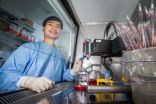(Press-News.org) Philadelphia, PA, September 9, 2014 – Necrotizing enterocolitis (NEC) is a devastating gastrointestinal illness affecting up to 10% of premature infants, with a 30% mortality rate, and formula feeding has been identified as a risk factor for NEC. A study published in The American Journal of Pathology found that growth factors present in human breast milk, but not in formula, may explain the protection against intestinal damage. Further, supplementing the diet of newborn NEC-affected rodents with these growth factors promotes epithelial cell survival.
"NEC is a highly morbid disease that can lead to multiple complications, including intestinal strictures, short gut syndrome, repeated surgeries, and extended hospital stays. Advances in understanding the growth factor signaling cascades that maintain the healthy developing intestine could lead to new methods for treating or preventing this devastating illness," says Mark R. Frey, PhD, The Saban Research Institute of Children's Hospital Los Angeles and the Keck School of Medicine of the University of Southern California.
Driving this research is the quest to understand how human breast milk protects infants from NEC. Soluble growth factors found in breast milk, such as epidermal growth factor (EGF) and heparin-binding EGF-like growth factor (HB-EGF), are thought to be possible protective molecules. Although both EGF and HB-EGF primarily activate the EGF receptor (EGFR), a member of the ErbB receptor tyrosine kinase family, HB-EGF also activates ErbB4 receptors. "We have recently demonstrated that NRG4, an ErbB4-specific ligand that does not bind or activate other family members, specifically promotes survival but not migration or proliferation of mouse colon epithelial cells," says Dr. Frey. Thus, NRG4 is a potentially unique and selective target for new therapies.
Because there is no one experimental model that replicates human NEC, the investigators conducted a series of in vivo and in vitro experiments using different animal models as well as analysis of human breast milk and intestinal tissue. The results all suggest that NRG4-ErbB4 signaling may play a key role in protecting the developing intestine from inflammatory insults, says Dr. Frey.
Human NEC has been associated with the loss of Paneth cells in the ileum. Paneth cells are found throughout the small intestine and are thought to be important components in the defense of gland stem cells from microbial damage. The investigators showed that NRG4 blocked Paneth cell loss in experimental mouse NEC. "This suggests that protection of Paneth cells or Paneth cell progenitors may be part of the mechanism of protection against NEC," says Dr. Frey, though as yet the mechanisms by which ErbB4 could regulate Paneth cell survival are not well defined.
In final experiments, the researchers analyzed the whey fractions of human milk from six anonymous donors, as well as formula controls, to see whether NRG4 is present normally in breast milk. Western blot analysis showed that all six breast milk specimens were positive for NRG4, whereas NRG4 was not detected in formula control samples. The authors also demonstrated that ErbB4 receptors were present in neonatal human small intestine, including samples from infants who currently have or recently had NEC, supporting a functional role in the intestines.
INFORMATION: END
Growth factors found in breast milk may protect against necrotizing enterocolitis
Studies suggest that ErbB4 receptor activation may be a novel therapeutic avenue for intestinal diseases involving epithelial cell death, according to research published in The American Journal of Pathology
2014-09-09
ELSE PRESS RELEASES FROM THIS DATE:
A weekly text message could encourage healthier food choices, new study shows
2014-09-09
Many people are unaware that the U.S. Food and Drug Administration's mandated nutrition labels are based on a 2,000-calorie-a-day diet, but a simple weekly text message reminder can greatly improve that awareness, according to a new study from the Johns Hopkins Bloomberg School of Public Health.
While not an outright recommendation, the 2,000-calorie benchmark is what the FDA considers a reasonable daily calorie intake for many adults. More importantly, nutrition labels on food products sold in the U.S. are based on it.
The key to translating nutrition labels and ...
The saplings go their own way
2014-09-09
This news release is available in German. Leipzig. In tropical rainforests, most young trees grow spatially independent from their parent trees. This means that it is not possible to predict where seedlings will take root, and less specialised species therefore have an advantage even in the species-rich rainforests of the tropics. This is the finding of a study, conducted by researchers at the Helmholtz Centre for Environmental Research (UFZ), the University of California and the Smithsonian Tropical Research Institute, the results of which were published recently in ...
Study sheds light on asthma and respiratory viruses
2014-09-09
People with asthma often have a hard time dealing with respiratory viruses such as the flu or the common cold, and researchers have struggled to explain why.
In a new study that compared people with and without asthma, the answer is becoming clearer. The researchers found no difference in the key immune response to viruses in the lungs and breathing passages. The work, at Washington University School of Medicine in St. Louis, suggests that a fundamental antiviral defense mechanism is intact in asthma. This means that another aspect of the immune system must explain the ...
Weakness in malaria parasite fats could see new treatments
2014-09-09
A new study has revealed a weak spot in the complex life cycle of malaria, which could be exploited to prevent the spread of the deadly disease.
It found female malaria parasites put on fat differently to male ones.
"The study opens potential new ways to combat malaria," said Associate Professor Alexander Maier, from The Australian National University Research School of Biology.
"Malaria parasites show resistance to all current anti-malarial drugs. We are losing our weapons against this very important disease. But by studying lipid molecules – fats – rather than ...
Eating is addictive but sugar and fat are not like drugs, study says
2014-09-09
People can become addicted to eating for its own sake but not to consuming specific foods such as those high in sugar or fat, research suggests.
An international team of scientists has found no strong evidence for people being addicted to the chemical substances in certain foods.
The brain does not respond to nutrients in the same way as it does to addictive drugs such as heroin or cocaine, the researchers say.
Instead, people can develop a psychological compulsion to eat, driven by the positive feelings that the brain associates with eating.
This is a behavioural ...
New methods enhance the quality of myocardial perfusion imaging
2014-09-09
New methods that enhance the quality of myocardial perfusion imaging were developed in a recent study completed at the University of Eastern Finland. In her PhD study, Tuija Kangasmaa, Lic. Phil., invented a method which makes it possible to reduce the imaging time by up to 50%, making the scan session easier for the patient. Furthermore, the study also created two additional methods which correct errors resulting from patient movement during the scan. The methods were validated and they have already been taken into use in hospitals all over the world.
Coronary artery ...
New infrared marker for bio-imaging
2014-09-09
Far-red shifted fluorescent tissue markers make it possible to visualize structures and processes with advanced bio-imaging. This permits new insights into organisms and creates the potential for a wide range of applications – from more exact delineation of tumor and metastasis through to tracking drug responses within whole-body imaging.
The team of scientists headed by Dr. Ulrike Schoetz, Dr. Nikolas Deliolanis, Dr. Wolfgang Beisker, Professor Horst Zitzelsberger und Randolph Caldwell from the Helmholtz Zentrum München have succeeded in developing novel fluorescent ...
Xenon gas protects the brain after head injury
2014-09-09
Treatment with xenon gas after a head injury reduces the extent of brain damage, according to a study in mice.
Head injury is the leading cause of death and disability in people aged under 45 in developed countries, mostly resulting from falls and road accidents. The primary injury caused by the initial mechanical force is followed by a secondary injury which develops in the hours and days afterwards. This secondary injury is largely responsible for patients' mental and physical disabilities, but there are currently no drug treatments that can be given after the accident ...
Winter is coming: British weather set to become more unsettled
2014-09-09
Britain hit by extremely unsettled winter weather
Three all-time high and two all-time low NAO values recorded in the last decade showing huge contrast in conditions
Month of December shows biggest variation in weather.
British winters are becoming increasingly volatile due to extreme variations in pressure over the North Atlantic according to scientists from the University of Sheffield.
The new research, published today (9 September 2014) in the International Journal of Climatology, shows that weather patterns over the UK have become distinctly more unstable, resulting ...
A single molecule diode opens up a new era for sustainable and miniature electronics
2014-09-09
In the domain of electronics, the continuous quest for miniaturisation is pushing us towards the creation of devices which are continuously becoming smaller and more efficient. However, silicon - the basic component for most of these devices which caused a true revolution in electronics - , begins to disclose its physical limits. The smaller the silicon system, the harder it gets to control its return. The point has been reached where scientists have started looking for alternative materials, better fit for the miniaturised formats.
One of the alternatives to provide ...
LAST 30 PRESS RELEASES:
Tracing the quick synthesis of an industrially important catalyst
New software sheds light on cancer’s hidden genetic networks
UT Health San Antonio awarded $3 million in CPRIT grants to bolster cancer research and prevention efforts in South Texas
Third symposium spotlights global challenge of new contaminants in China’s fight against pollution
From straw to soil harmony: International team reveals how biochar supercharges carbon-smart farming
Myeloma: How AI is redrawing the map of cancer care
Manhattan E. Charurat, Ph.D., MHS invested as the Homer and Martha Gudelsky Distinguished Professor in Medicine at the University of Maryland School of Medicine
Insilico Medicine’s Pharma.AI Q4 Winter Launch Recap: Revolutionizing drug discovery with cutting-edge AI innovations, accelerating the path to pharmaceutical superintelligence
Nanoplastics have diet-dependent impacts on digestive system health
Brain neuron death occurs throughout life and increases with age, a natural human protein drug may halt neuron death in Alzheimer’s disease
SPIE and CLP announce the recipients of the 2025 Advanced Photonics Young Innovator Award
Lessons from the Caldor Fire’s Christmas Valley ‘Miracle’
Ant societies rose by trading individual protection for collective power
Research reveals how ancient viral DNA shapes early embryonic development
A molecular gatekeeper that controls protein synthesis
New ‘cloaking device’ concept to shield sensitive tech from magnetic fields
Researchers show impact of mountain building and climate change on alpine biodiversity
Study models the transition from Neanderthals to modern humans in Europe
University of Phoenix College of Doctoral Studies releases white paper on AI-driven skilling to reduce burnout and restore worker autonomy
AIs fail at the game of visual “telephone”
The levers for a sustainable food system
Potential changes in US homelessness by ending federal support for housing first programs
Vulnerability of large language models to prompt injection when providing medical advice
Researchers develop new system for high-energy-density, long-life, multi-electron transfer bromine-based flow batteries
Ending federal support for housing first programs could increase U.S. homelessness by 5% in one year, new JAMA study finds
New research uncovers molecular ‘safety switch’ shielding cancers from immune attack
Bacteria resisting viral infection can still sink carbon to ocean floor
Younger biological age may increase depression risk in older women during COVID-19
Bharat Innovates 2026 National Basecamp Showcases India’s Most Promising Deep-Tech Ventures
Here’s what determines whether your income level rises or falls
[Press-News.org] Growth factors found in breast milk may protect against necrotizing enterocolitisStudies suggest that ErbB4 receptor activation may be a novel therapeutic avenue for intestinal diseases involving epithelial cell death, according to research published in The American Journal of Pathology

